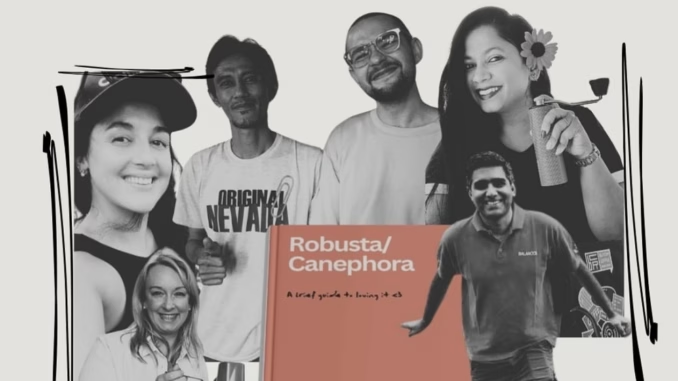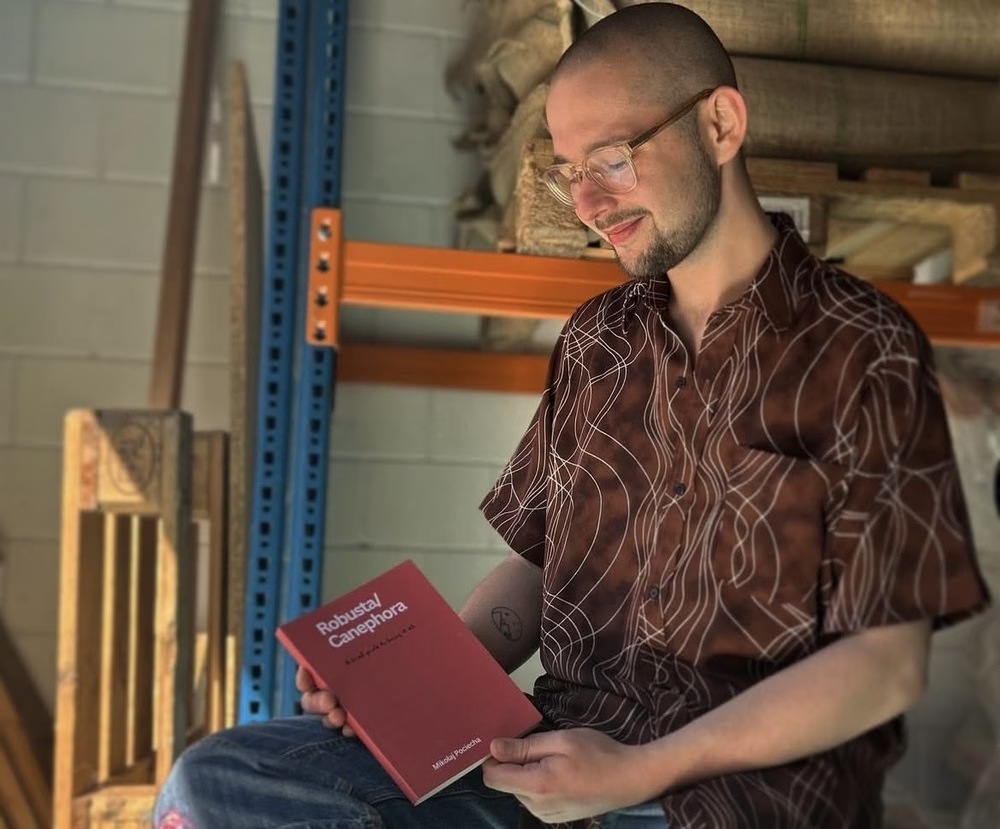A New Book for Your Coffee Table: A Review of ’Robusta/Canephora’ by Mikolaj Pociecha

Mikolaj Pociecha continues his exploration of all things canephora with his latest book. Today, we share an overview and exclusive review of the recent release.
BY TANYA NANETTI
SENIOR ONLINE CORRESPONDENT
Photos courtesy of Mikolaj Pociecha
Mikolaj Pociecha is a household name for anyone interested in finding out more about the canephora coffee species. A barista, roaster, and writer, Mikolaj published a small book a couple of years ago called “Canephora,” which, through interviews, technical insights, and deep reflections, introduces newbies and connoisseurs to the interesting world of canephora. After months of study and research, Mikolaj is ready to return to the subject thanks to his latest book, “Robusta/Canephora (a brief guide to loving it),” an ideal sequel to the first book.
After finally meeting Mikolaj in person at the most recent Amsterdam Coffee Festival, I had the unique opportunity to read the book before its official release this past May—an opportunity that allowed me to find out more about this often overlooked species.


Initial Thoughts + the Book’s Introduction
Right from the first page, it is clear what Mikolaj’s purpose was in writing the book, which was created with the goal of being “a valuable resource for learning how to appreciate and work with canephora/robusta as a coffee professional.” Basically, the book is a short essay that can teach baristas and roasters (but also anyone simply interested in the subject) how to learn to love the coffee species.
At first glance, the book’s list of its 20 chapters—which promise to cover everything about robusta—already piqued my curiosity. Mikolaj’s journey promises to take readers from the basics of the species to its specific flavors, to suggested strategies on how best to roast, prepare, and enjoy it—all peppered with interviews with some canephora connoisseurs.
Intrigued, I jumped into the reading.
After a little clarification on the purpose of the book (which was initially supposed to be focused on how to roast canephora, but has since shifted to being a more comprehensive book, to avoid too much heaviness), Mikolaj states in the introduction what the following chapters will be about: not only providing valuable insights into the roasting process, but also “to discuss this topic along with others in relation to the species, people, and the challenges we face.”


Delving Deeper
Finally, it was time to start the book.
A brief background of canephora—covering different facts about the species, from genetics to the dark history of coffee’s connection to colonialism—precedes a small chapter focusing on the best way to refer to the species. Is it better to go by the more widely used “robusta,” or is it better to adopt the more scientific term “canephora”?
SPOILER: Both terms have a long history, and both can have positive and negative overtones, depending on the context (which is why, for the rest of the piece, I will use them interchangeably). As Mikolaj explains, “The species was originally named ‘Coffea canephora’ by Luis Pierre in 1895. It was first sent to Java, Indonesia (then a Dutch colony), under the name ‘robusta’ between 1889 and 1900 by the Netherlands. For better or worse, the name stuck.”
Mikolaj continues, “Robusta has often been perceived as inferior, leading to a stigma around the name. In this context, the term ‘Coffea canephora’ provides some relief from that negative perception.”
Special Guests Throughout the Book
After delving into the name issue, it is time for Mikolaj to include the first of many interesting guests. Here, Isabelle Mani, a writer and coffee researcher, shares all her knowledge about the history and economics of robusta. This is a brief history of the species, from its original “industrial” destination to specialty canephora, with, in between, an interesting recollection of robusta’s rise in popularity due to the spread of soluble coffee post-World War II.
Then comes a quick overview from Isabelle on robusta genetics and scientific research, and finally, an overview of what is happening today in relation to canephora (fermentation techniques, the canephora aroma wheel, etc.).
From here on, the book goes on to mix chapters by Mikolaj himself (dealing with the taste of robusta, a recollection of the best robustas the author has experienced over the years, and information on the best water to use for brewing canephora) with some other interviews. Judith Konsten, selector of Q Robusta and Q Arabica, presents the fine robusta and its unique qualities; Reza Nurullah, a coffee farmer from Central Java, shares his immense knowledge of all things robusta, including his tips for processing, roasting, and brewing; and Rohan Kuriyan, a fifth-generation farmer from India specializing in coffee, tea, pepper, and areca nut, shares his family approach to growing and processing robusta.



Conclusion + A Final Guest Author
It is then time for Mikolaj to conclude the book with the two longest chapters, interrupted by the intervention of a final guest speaker. The chapter “Recipes” is itself divided into two parts, which include recipes labeled “NA” (three separate recipes for ibrik, Pulsar, and pourover), and “The Bar,” which includes recipes for an espresso martini, negroni cold brew and Irish coffee, using canephora as the base for the coffee, which the books describes as perfect because of “its boldness, viscosity, and familiar delicious coffee flavor.”
The valuable contribution by Bhavi Patel, “Tasting Canephora and Talking About It,” is the last lengthy guest essay included in the book, before Mikolaj takes the floor one last time for the most crucial part, “The Roasting Section.” As Mikolaj shares from the beginning, this is the main topic he initially sought to cover.
Analyzing everything there is to know, from double-layer defects to temperature control, smokey and baked flavors, and so on, this last chapter is a broad overview of everything related to roasting canephora, including guidelines for drum roasters and an example of a roasting profile. Definitely the hardest part to read if you are not already a roasting enthusiast, with its many graphs and scientific and technical explanations, this last chapter is tailor-made for those already familiar with roasting techniques.
A Book for Newcomers and Connoisseurs Alike
Regardless of the more technical parts of the book, overall, Mikolaj’s “Robusta/Canephora” is something that can appeal to all those who are interested in learning more about canephora—whether professionals or just coffee lovers—thanks to the engaging writing technique and interesting topics covered.
As he set out to do from the very beginning, Mikolaj has succeeded in hitting his goal in full: to thoroughly explain all the nerdier things about canephora, while maintaining a well-deserved focus on the people and stories behind it, to give more than necessary meaning and background. It’s definitely a must-read for anyone even remotely interested in learning more about robusta.
To order a copy, click here.
ABOUT THE AUTHOR
Tanya Nanetti (she/her) is a specialty-coffee barista, a traveler, and a dreamer. When she’s not behind the coffee machine (or visiting some hidden corner of the world), she’s busy writing for Coffee Insurrection, a website about specialty coffee that she’s creating along with her boyfriend.
Subscribe and More!
As always, you can read Barista Magazine in paper by subscribing or ordering an issue.
Read the June + July 2025 Issue for free with our digital edition.
For free access to more than five years’ worth of issues, visit our digital edition archives here.
Source: Barista Magazine



